Strategic Management Report: IKEA's Market Analysis and Strategy
VerifiedAdded on 2023/01/05
|31
|7248
|149
Report
AI Summary
This report provides a comprehensive strategic analysis of IKEA, examining its external and internal environments. It begins with an introduction to strategic management and the chosen organization, IKEA, highlighting its vision, mission, and the challenges it faces, particularly in maintaining product quality and navigating new markets. The main body delves into macro and micro environmental analyses, employing PESTLE and Porter's Five Forces frameworks to assess political, economic, social, technological, environmental, and legal factors, as well as competitive dynamics. The report also considers the industry life cycle stage and customer segmentation strategies. Furthermore, it identifies key opportunities and threats for IKEA, followed by an internal environment capability analysis. It then explores strategic options for the company and proposes strategies, concluding with the challenges in implementing these strategies.
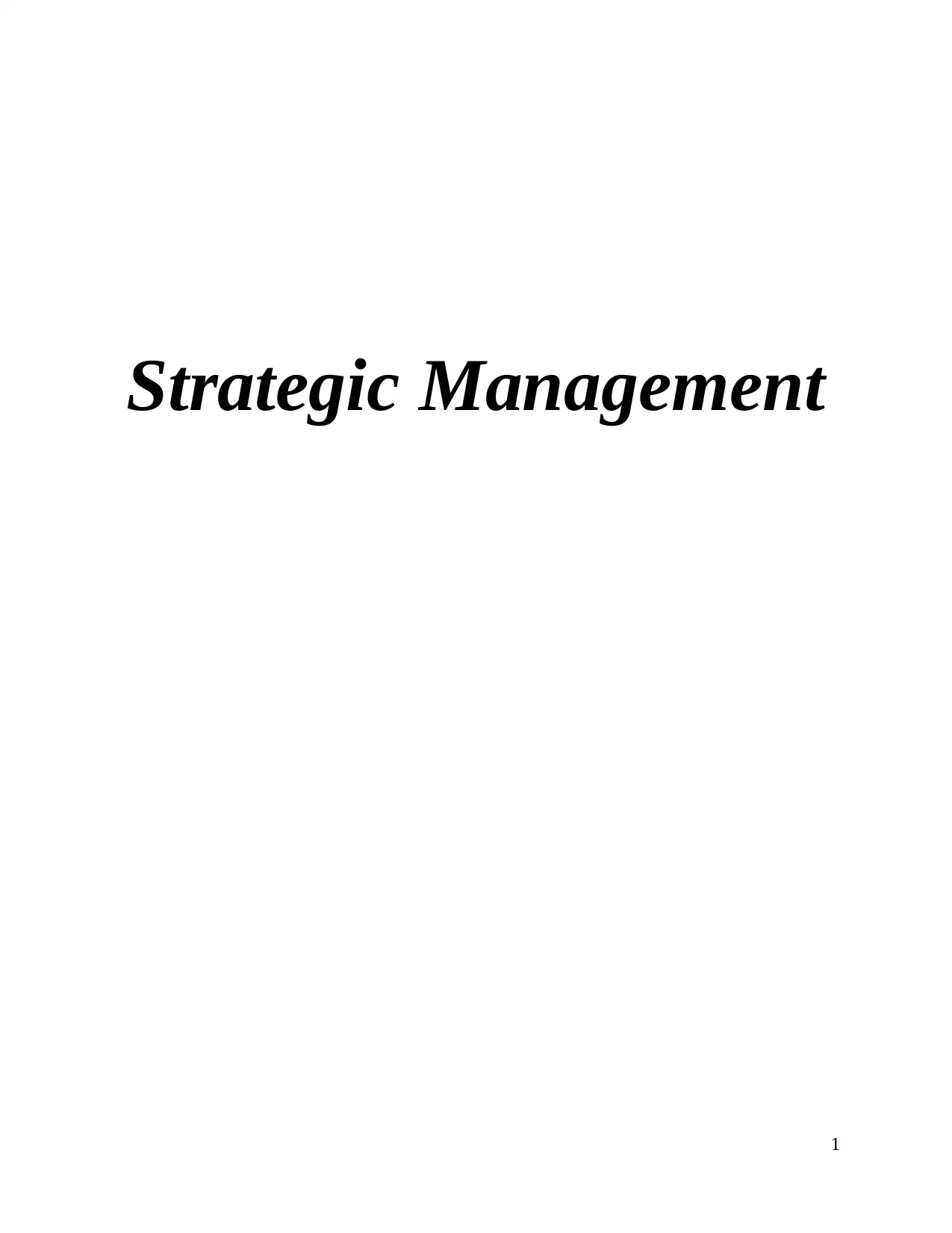
Strategic Management
1
1
Paraphrase This Document
Need a fresh take? Get an instant paraphrase of this document with our AI Paraphraser
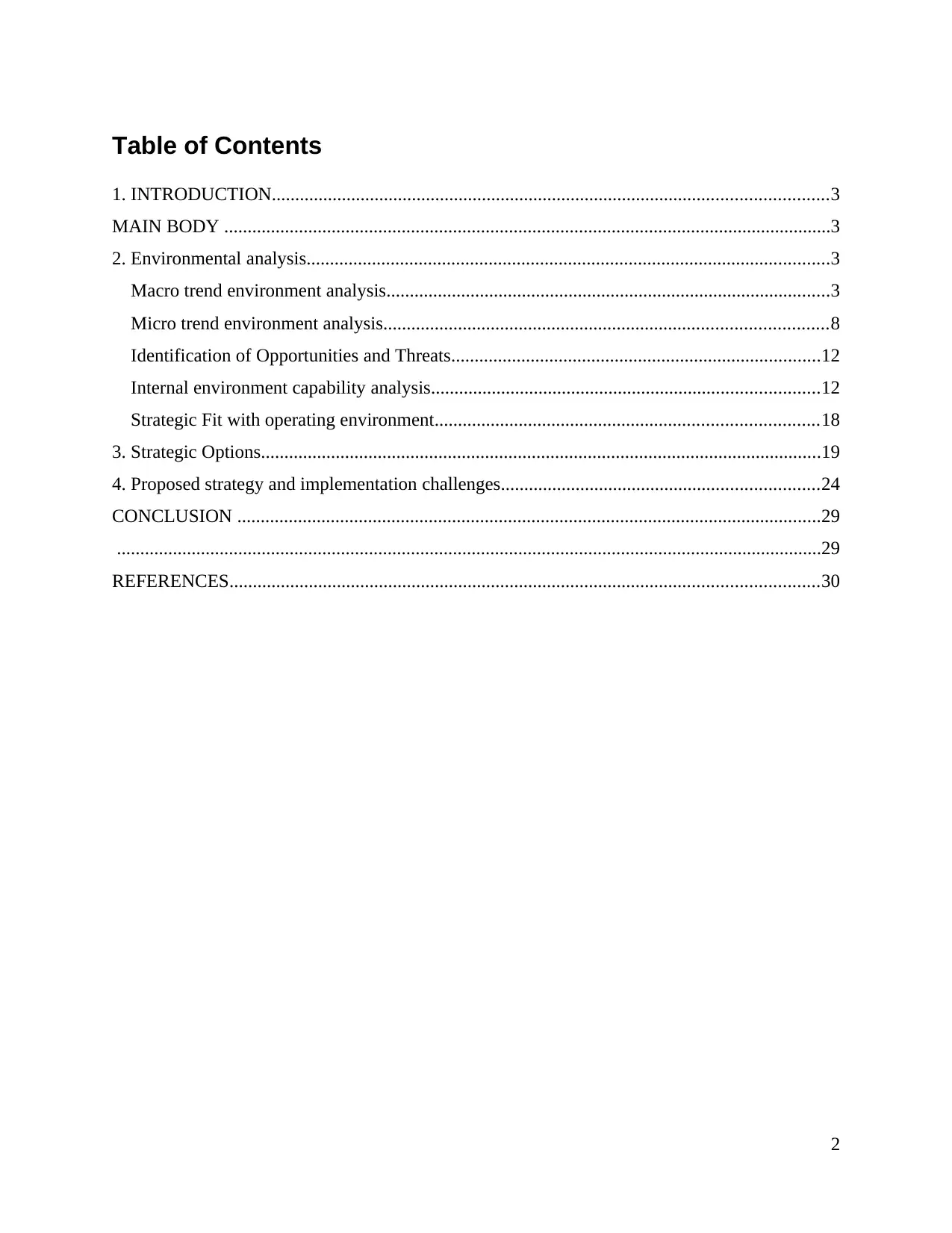
Table of Contents
1. INTRODUCTION.......................................................................................................................3
MAIN BODY ..................................................................................................................................3
2. Environmental analysis................................................................................................................3
Macro trend environment analysis...............................................................................................3
Micro trend environment analysis...............................................................................................8
Identification of Opportunities and Threats...............................................................................12
Internal environment capability analysis...................................................................................12
Strategic Fit with operating environment..................................................................................18
3. Strategic Options........................................................................................................................19
4. Proposed strategy and implementation challenges....................................................................24
CONCLUSION .............................................................................................................................29
.......................................................................................................................................................29
REFERENCES..............................................................................................................................30
2
1. INTRODUCTION.......................................................................................................................3
MAIN BODY ..................................................................................................................................3
2. Environmental analysis................................................................................................................3
Macro trend environment analysis...............................................................................................3
Micro trend environment analysis...............................................................................................8
Identification of Opportunities and Threats...............................................................................12
Internal environment capability analysis...................................................................................12
Strategic Fit with operating environment..................................................................................18
3. Strategic Options........................................................................................................................19
4. Proposed strategy and implementation challenges....................................................................24
CONCLUSION .............................................................................................................................29
.......................................................................................................................................................29
REFERENCES..............................................................................................................................30
2
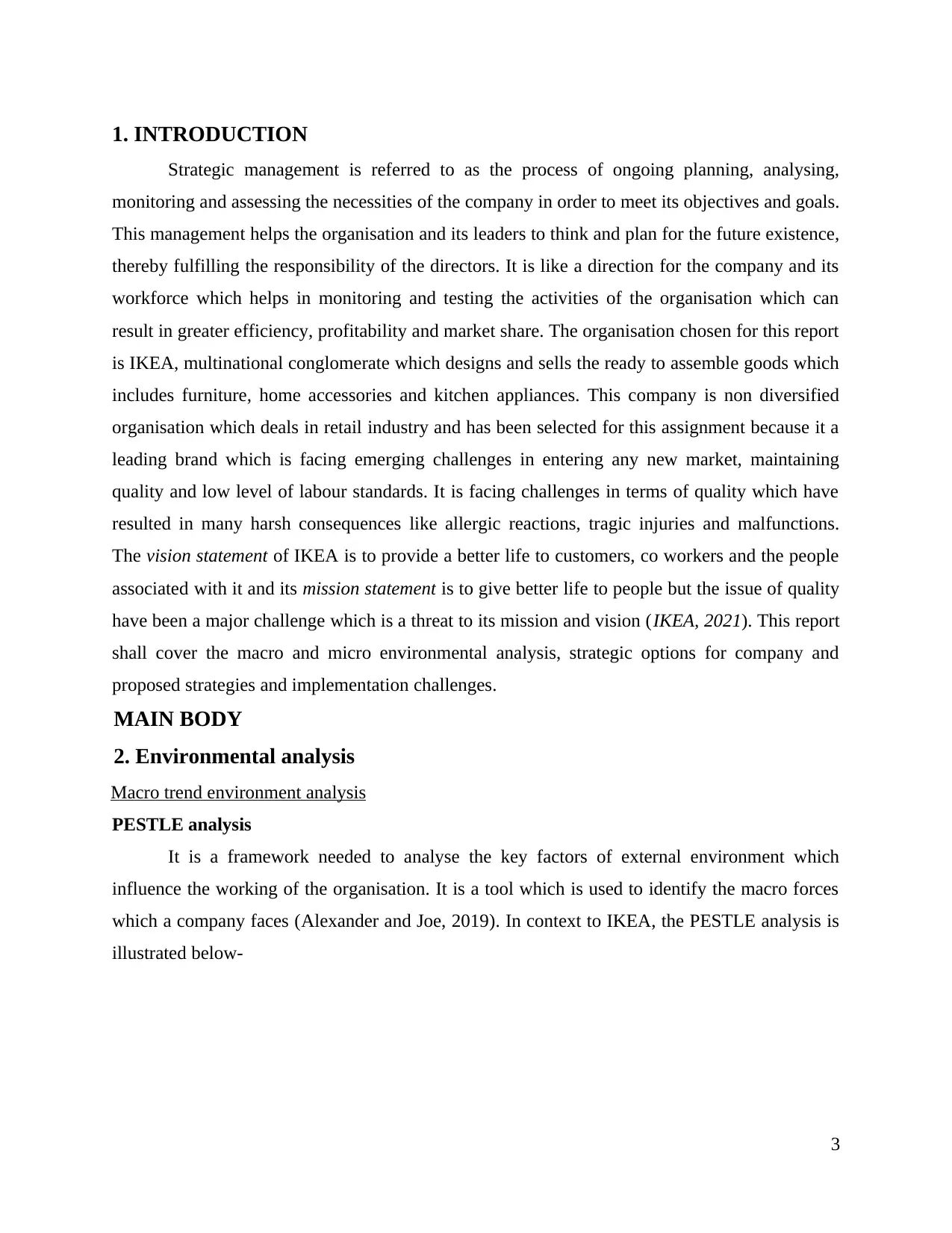
1. INTRODUCTION
Strategic management is referred to as the process of ongoing planning, analysing,
monitoring and assessing the necessities of the company in order to meet its objectives and goals.
This management helps the organisation and its leaders to think and plan for the future existence,
thereby fulfilling the responsibility of the directors. It is like a direction for the company and its
workforce which helps in monitoring and testing the activities of the organisation which can
result in greater efficiency, profitability and market share. The organisation chosen for this report
is IKEA, multinational conglomerate which designs and sells the ready to assemble goods which
includes furniture, home accessories and kitchen appliances. This company is non diversified
organisation which deals in retail industry and has been selected for this assignment because it a
leading brand which is facing emerging challenges in entering any new market, maintaining
quality and low level of labour standards. It is facing challenges in terms of quality which have
resulted in many harsh consequences like allergic reactions, tragic injuries and malfunctions.
The vision statement of IKEA is to provide a better life to customers, co workers and the people
associated with it and its mission statement is to give better life to people but the issue of quality
have been a major challenge which is a threat to its mission and vision (IKEA, 2021). This report
shall cover the macro and micro environmental analysis, strategic options for company and
proposed strategies and implementation challenges.
MAIN BODY
2. Environmental analysis
Macro trend environment analysis
PESTLE analysis
It is a framework needed to analyse the key factors of external environment which
influence the working of the organisation. It is a tool which is used to identify the macro forces
which a company faces (Alexander and Joe, 2019). In context to IKEA, the PESTLE analysis is
illustrated below-
3
Strategic management is referred to as the process of ongoing planning, analysing,
monitoring and assessing the necessities of the company in order to meet its objectives and goals.
This management helps the organisation and its leaders to think and plan for the future existence,
thereby fulfilling the responsibility of the directors. It is like a direction for the company and its
workforce which helps in monitoring and testing the activities of the organisation which can
result in greater efficiency, profitability and market share. The organisation chosen for this report
is IKEA, multinational conglomerate which designs and sells the ready to assemble goods which
includes furniture, home accessories and kitchen appliances. This company is non diversified
organisation which deals in retail industry and has been selected for this assignment because it a
leading brand which is facing emerging challenges in entering any new market, maintaining
quality and low level of labour standards. It is facing challenges in terms of quality which have
resulted in many harsh consequences like allergic reactions, tragic injuries and malfunctions.
The vision statement of IKEA is to provide a better life to customers, co workers and the people
associated with it and its mission statement is to give better life to people but the issue of quality
have been a major challenge which is a threat to its mission and vision (IKEA, 2021). This report
shall cover the macro and micro environmental analysis, strategic options for company and
proposed strategies and implementation challenges.
MAIN BODY
2. Environmental analysis
Macro trend environment analysis
PESTLE analysis
It is a framework needed to analyse the key factors of external environment which
influence the working of the organisation. It is a tool which is used to identify the macro forces
which a company faces (Alexander and Joe, 2019). In context to IKEA, the PESTLE analysis is
illustrated below-
3
⊘ This is a preview!⊘
Do you want full access?
Subscribe today to unlock all pages.

Trusted by 1+ million students worldwide
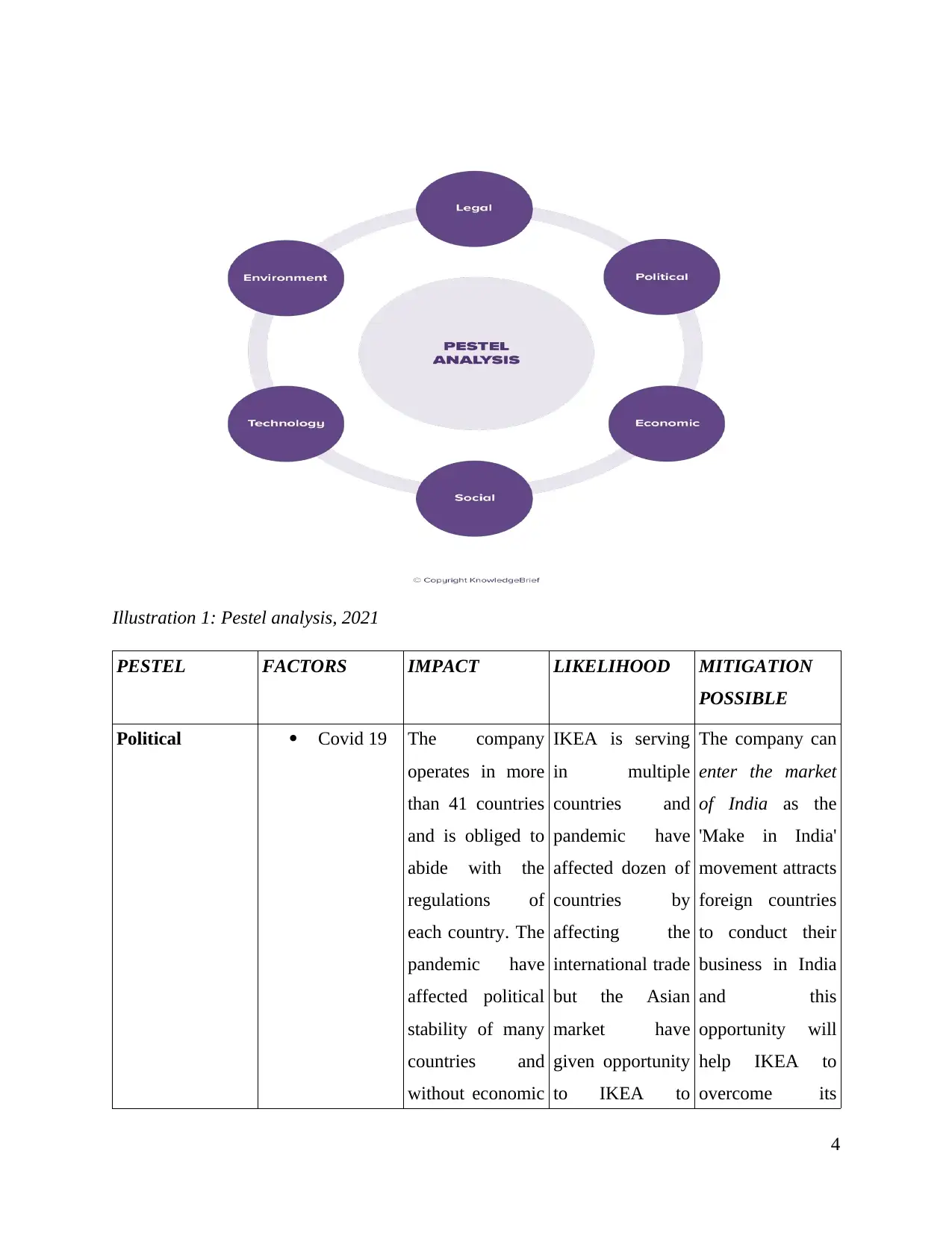
Illustration 1: Pestel analysis, 2021
PESTEL FACTORS IMPACT LIKELIHOOD MITIGATION
POSSIBLE
Political Covid 19 The company
operates in more
than 41 countries
and is obliged to
abide with the
regulations of
each country. The
pandemic have
affected political
stability of many
countries and
without economic
IKEA is serving
in multiple
countries and
pandemic have
affected dozen of
countries by
affecting the
international trade
but the Asian
market have
given opportunity
to IKEA to
The company can
enter the market
of India as the
'Make in India'
movement attracts
foreign countries
to conduct their
business in India
and this
opportunity will
help IKEA to
overcome its
4
PESTEL FACTORS IMPACT LIKELIHOOD MITIGATION
POSSIBLE
Political Covid 19 The company
operates in more
than 41 countries
and is obliged to
abide with the
regulations of
each country. The
pandemic have
affected political
stability of many
countries and
without economic
IKEA is serving
in multiple
countries and
pandemic have
affected dozen of
countries by
affecting the
international trade
but the Asian
market have
given opportunity
to IKEA to
The company can
enter the market
of India as the
'Make in India'
movement attracts
foreign countries
to conduct their
business in India
and this
opportunity will
help IKEA to
overcome its
4
Paraphrase This Document
Need a fresh take? Get an instant paraphrase of this document with our AI Paraphraser
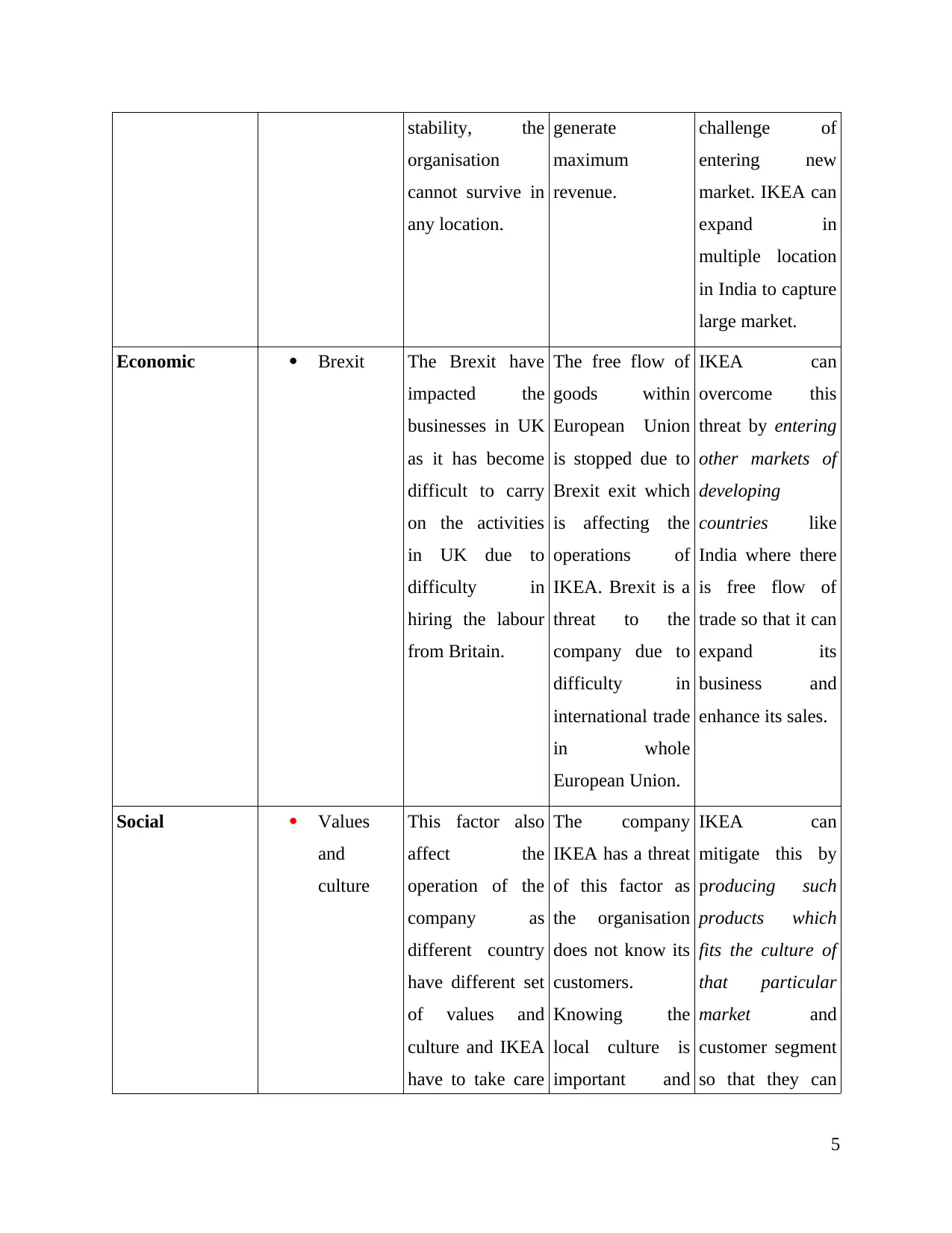
stability, the
organisation
cannot survive in
any location.
generate
maximum
revenue.
challenge of
entering new
market. IKEA can
expand in
multiple location
in India to capture
large market.
Economic Brexit The Brexit have
impacted the
businesses in UK
as it has become
difficult to carry
on the activities
in UK due to
difficulty in
hiring the labour
from Britain.
The free flow of
goods within
European Union
is stopped due to
Brexit exit which
is affecting the
operations of
IKEA. Brexit is a
threat to the
company due to
difficulty in
international trade
in whole
European Union.
IKEA can
overcome this
threat by entering
other markets of
developing
countries like
India where there
is free flow of
trade so that it can
expand its
business and
enhance its sales.
Social Values
and
culture
This factor also
affect the
operation of the
company as
different country
have different set
of values and
culture and IKEA
have to take care
The company
IKEA has a threat
of this factor as
the organisation
does not know its
customers.
Knowing the
local culture is
important and
IKEA can
mitigate this by
producing such
products which
fits the culture of
that particular
market and
customer segment
so that they can
5
organisation
cannot survive in
any location.
generate
maximum
revenue.
challenge of
entering new
market. IKEA can
expand in
multiple location
in India to capture
large market.
Economic Brexit The Brexit have
impacted the
businesses in UK
as it has become
difficult to carry
on the activities
in UK due to
difficulty in
hiring the labour
from Britain.
The free flow of
goods within
European Union
is stopped due to
Brexit exit which
is affecting the
operations of
IKEA. Brexit is a
threat to the
company due to
difficulty in
international trade
in whole
European Union.
IKEA can
overcome this
threat by entering
other markets of
developing
countries like
India where there
is free flow of
trade so that it can
expand its
business and
enhance its sales.
Social Values
and
culture
This factor also
affect the
operation of the
company as
different country
have different set
of values and
culture and IKEA
have to take care
The company
IKEA has a threat
of this factor as
the organisation
does not know its
customers.
Knowing the
local culture is
important and
IKEA can
mitigate this by
producing such
products which
fits the culture of
that particular
market and
customer segment
so that they can
5
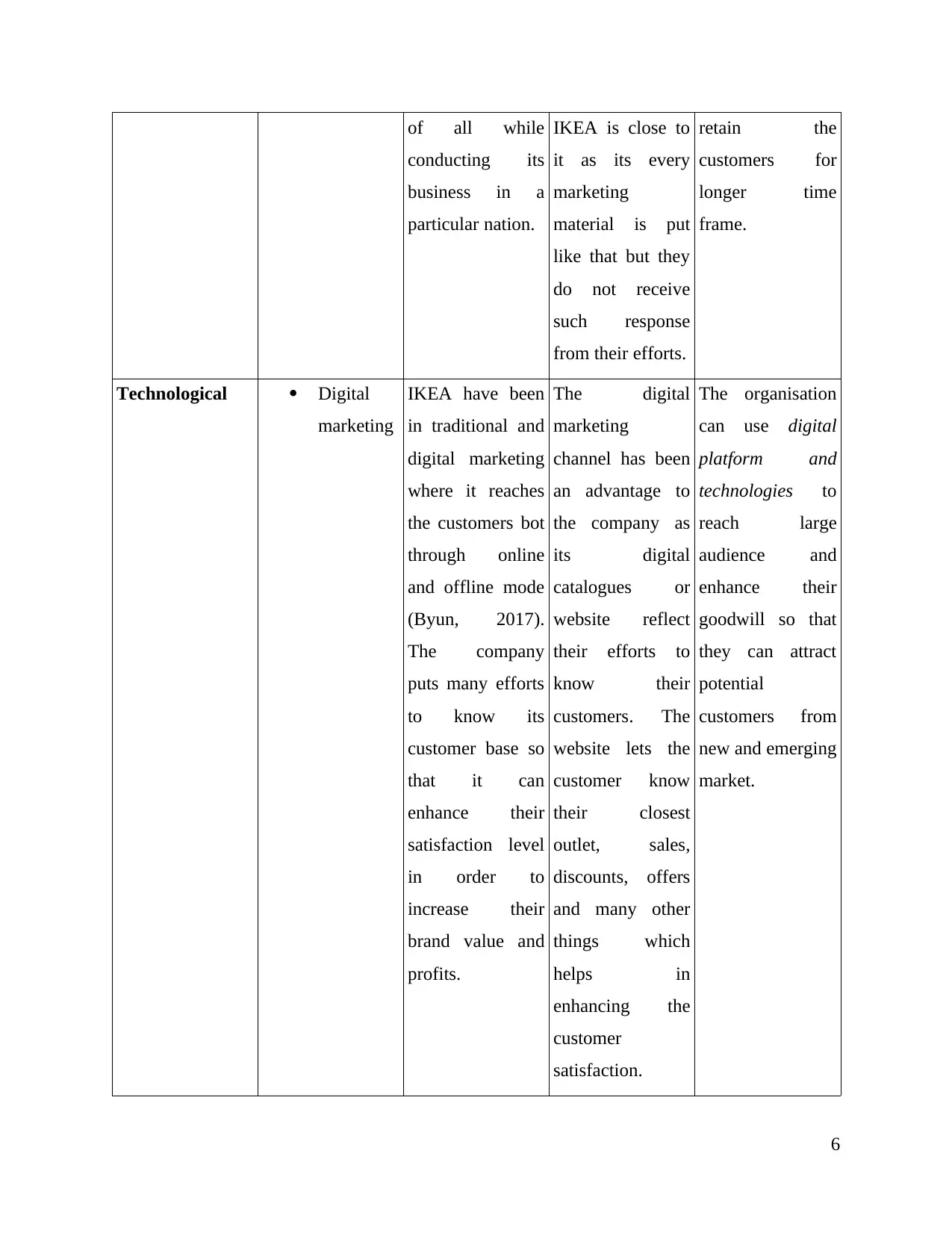
of all while
conducting its
business in a
particular nation.
IKEA is close to
it as its every
marketing
material is put
like that but they
do not receive
such response
from their efforts.
retain the
customers for
longer time
frame.
Technological Digital
marketing
IKEA have been
in traditional and
digital marketing
where it reaches
the customers bot
through online
and offline mode
(Byun, 2017).
The company
puts many efforts
to know its
customer base so
that it can
enhance their
satisfaction level
in order to
increase their
brand value and
profits.
The digital
marketing
channel has been
an advantage to
the company as
its digital
catalogues or
website reflect
their efforts to
know their
customers. The
website lets the
customer know
their closest
outlet, sales,
discounts, offers
and many other
things which
helps in
enhancing the
customer
satisfaction.
The organisation
can use digital
platform and
technologies to
reach large
audience and
enhance their
goodwill so that
they can attract
potential
customers from
new and emerging
market.
6
conducting its
business in a
particular nation.
IKEA is close to
it as its every
marketing
material is put
like that but they
do not receive
such response
from their efforts.
retain the
customers for
longer time
frame.
Technological Digital
marketing
IKEA have been
in traditional and
digital marketing
where it reaches
the customers bot
through online
and offline mode
(Byun, 2017).
The company
puts many efforts
to know its
customer base so
that it can
enhance their
satisfaction level
in order to
increase their
brand value and
profits.
The digital
marketing
channel has been
an advantage to
the company as
its digital
catalogues or
website reflect
their efforts to
know their
customers. The
website lets the
customer know
their closest
outlet, sales,
discounts, offers
and many other
things which
helps in
enhancing the
customer
satisfaction.
The organisation
can use digital
platform and
technologies to
reach large
audience and
enhance their
goodwill so that
they can attract
potential
customers from
new and emerging
market.
6
⊘ This is a preview!⊘
Do you want full access?
Subscribe today to unlock all pages.

Trusted by 1+ million students worldwide
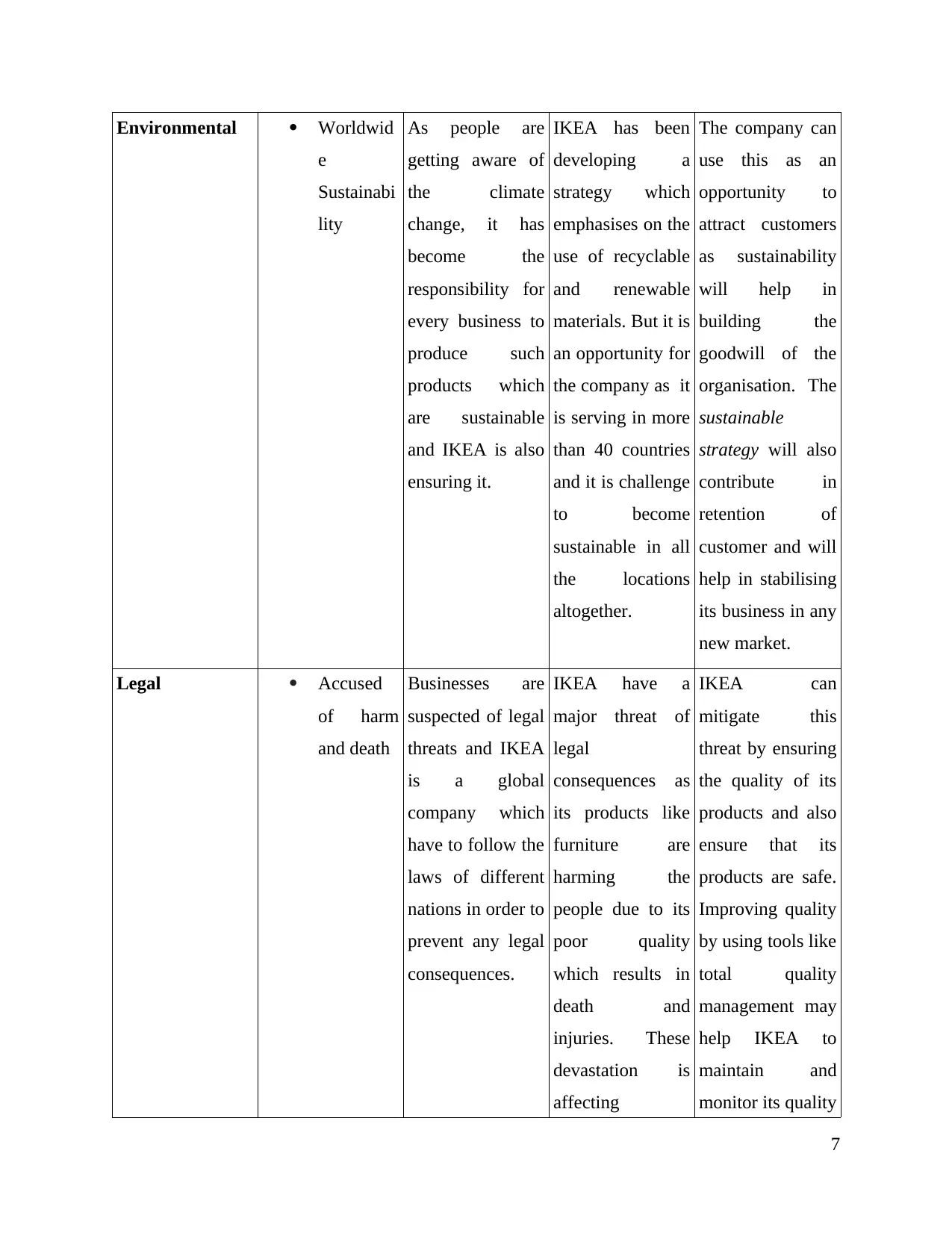
Environmental Worldwid
e
Sustainabi
lity
As people are
getting aware of
the climate
change, it has
become the
responsibility for
every business to
produce such
products which
are sustainable
and IKEA is also
ensuring it.
IKEA has been
developing a
strategy which
emphasises on the
use of recyclable
and renewable
materials. But it is
an opportunity for
the company as it
is serving in more
than 40 countries
and it is challenge
to become
sustainable in all
the locations
altogether.
The company can
use this as an
opportunity to
attract customers
as sustainability
will help in
building the
goodwill of the
organisation. The
sustainable
strategy will also
contribute in
retention of
customer and will
help in stabilising
its business in any
new market.
Legal Accused
of harm
and death
Businesses are
suspected of legal
threats and IKEA
is a global
company which
have to follow the
laws of different
nations in order to
prevent any legal
consequences.
IKEA have a
major threat of
legal
consequences as
its products like
furniture are
harming the
people due to its
poor quality
which results in
death and
injuries. These
devastation is
affecting
IKEA can
mitigate this
threat by ensuring
the quality of its
products and also
ensure that its
products are safe.
Improving quality
by using tools like
total quality
management may
help IKEA to
maintain and
monitor its quality
7
e
Sustainabi
lity
As people are
getting aware of
the climate
change, it has
become the
responsibility for
every business to
produce such
products which
are sustainable
and IKEA is also
ensuring it.
IKEA has been
developing a
strategy which
emphasises on the
use of recyclable
and renewable
materials. But it is
an opportunity for
the company as it
is serving in more
than 40 countries
and it is challenge
to become
sustainable in all
the locations
altogether.
The company can
use this as an
opportunity to
attract customers
as sustainability
will help in
building the
goodwill of the
organisation. The
sustainable
strategy will also
contribute in
retention of
customer and will
help in stabilising
its business in any
new market.
Legal Accused
of harm
and death
Businesses are
suspected of legal
threats and IKEA
is a global
company which
have to follow the
laws of different
nations in order to
prevent any legal
consequences.
IKEA have a
major threat of
legal
consequences as
its products like
furniture are
harming the
people due to its
poor quality
which results in
death and
injuries. These
devastation is
affecting
IKEA can
mitigate this
threat by ensuring
the quality of its
products and also
ensure that its
products are safe.
Improving quality
by using tools like
total quality
management may
help IKEA to
maintain and
monitor its quality
7
Paraphrase This Document
Need a fresh take? Get an instant paraphrase of this document with our AI Paraphraser
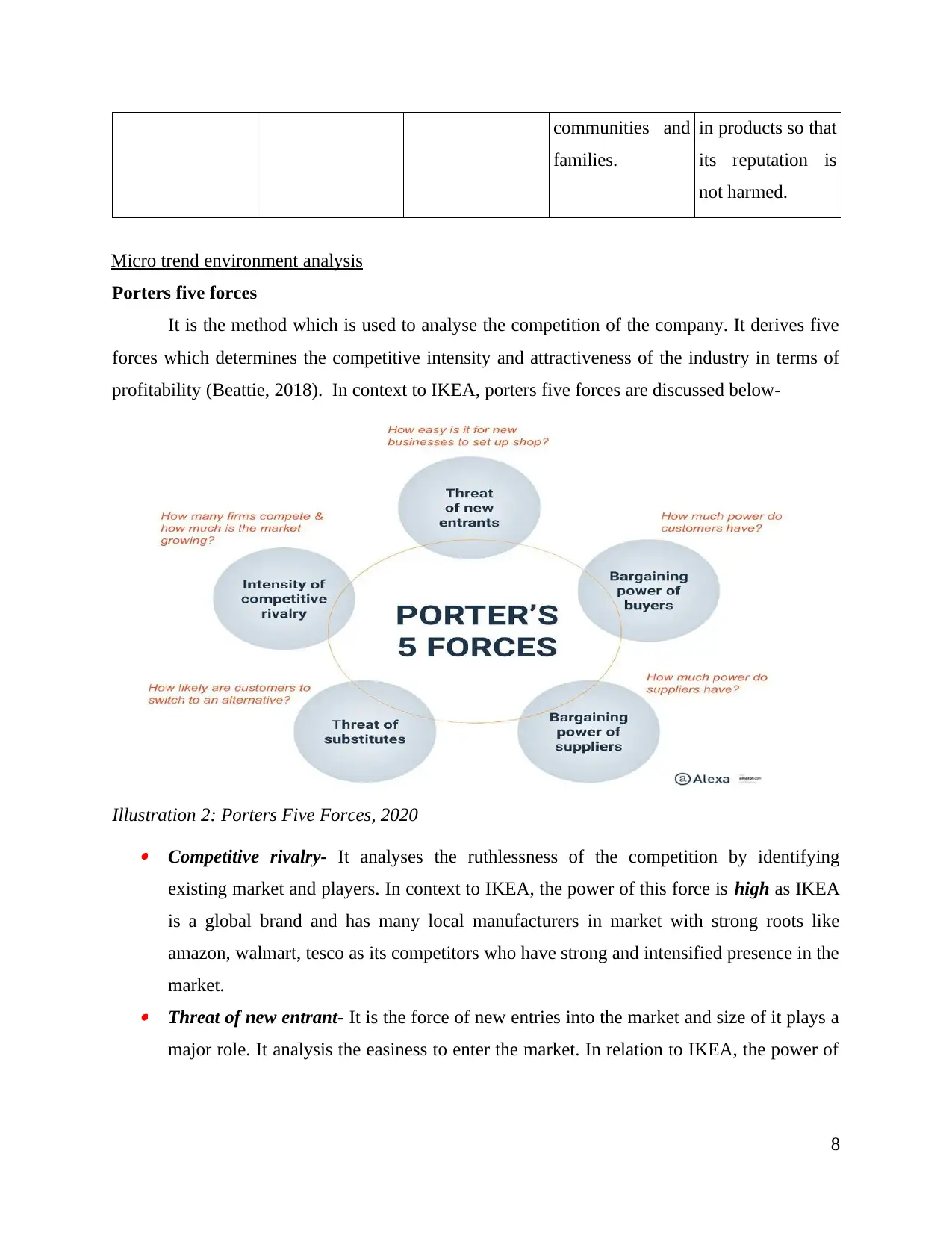
communities and
families.
in products so that
its reputation is
not harmed.
Micro trend environment analysis
Porters five forces
It is the method which is used to analyse the competition of the company. It derives five
forces which determines the competitive intensity and attractiveness of the industry in terms of
profitability (Beattie, 2018). In context to IKEA, porters five forces are discussed below-
Illustration 2: Porters Five Forces, 2020 Competitive rivalry- It analyses the ruthlessness of the competition by identifying
existing market and players. In context to IKEA, the power of this force is high as IKEA
is a global brand and has many local manufacturers in market with strong roots like
amazon, walmart, tesco as its competitors who have strong and intensified presence in the
market. Threat of new entrant- It is the force of new entries into the market and size of it plays a
major role. It analysis the easiness to enter the market. In relation to IKEA, the power of
8
families.
in products so that
its reputation is
not harmed.
Micro trend environment analysis
Porters five forces
It is the method which is used to analyse the competition of the company. It derives five
forces which determines the competitive intensity and attractiveness of the industry in terms of
profitability (Beattie, 2018). In context to IKEA, porters five forces are discussed below-
Illustration 2: Porters Five Forces, 2020 Competitive rivalry- It analyses the ruthlessness of the competition by identifying
existing market and players. In context to IKEA, the power of this force is high as IKEA
is a global brand and has many local manufacturers in market with strong roots like
amazon, walmart, tesco as its competitors who have strong and intensified presence in the
market. Threat of new entrant- It is the force of new entries into the market and size of it plays a
major role. It analysis the easiness to enter the market. In relation to IKEA, the power of
8
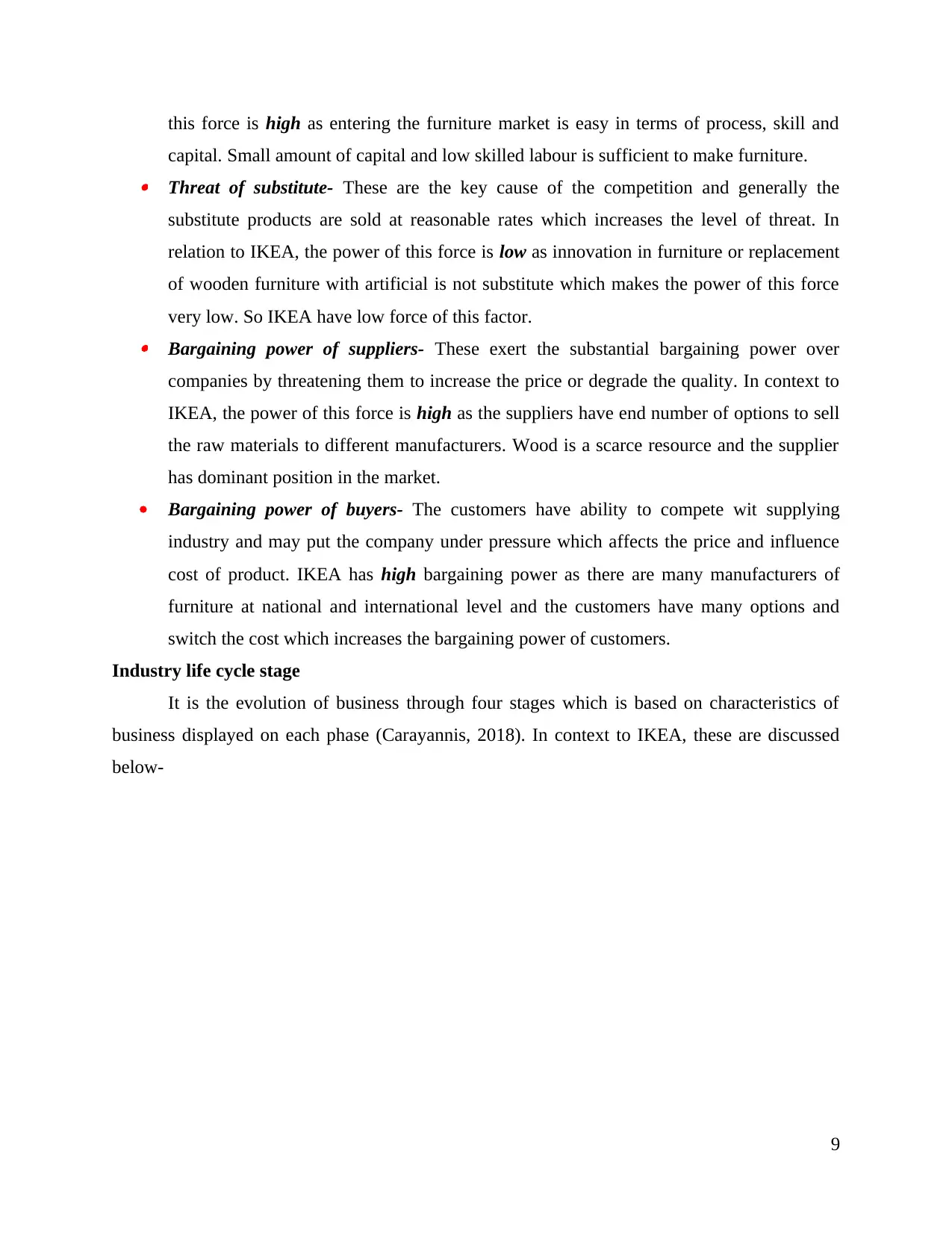
this force is high as entering the furniture market is easy in terms of process, skill and
capital. Small amount of capital and low skilled labour is sufficient to make furniture. Threat of substitute- These are the key cause of the competition and generally the
substitute products are sold at reasonable rates which increases the level of threat. In
relation to IKEA, the power of this force is low as innovation in furniture or replacement
of wooden furniture with artificial is not substitute which makes the power of this force
very low. So IKEA have low force of this factor. Bargaining power of suppliers- These exert the substantial bargaining power over
companies by threatening them to increase the price or degrade the quality. In context to
IKEA, the power of this force is high as the suppliers have end number of options to sell
the raw materials to different manufacturers. Wood is a scarce resource and the supplier
has dominant position in the market.
Bargaining power of buyers- The customers have ability to compete wit supplying
industry and may put the company under pressure which affects the price and influence
cost of product. IKEA has high bargaining power as there are many manufacturers of
furniture at national and international level and the customers have many options and
switch the cost which increases the bargaining power of customers.
Industry life cycle stage
It is the evolution of business through four stages which is based on characteristics of
business displayed on each phase (Carayannis, 2018). In context to IKEA, these are discussed
below-
9
capital. Small amount of capital and low skilled labour is sufficient to make furniture. Threat of substitute- These are the key cause of the competition and generally the
substitute products are sold at reasonable rates which increases the level of threat. In
relation to IKEA, the power of this force is low as innovation in furniture or replacement
of wooden furniture with artificial is not substitute which makes the power of this force
very low. So IKEA have low force of this factor. Bargaining power of suppliers- These exert the substantial bargaining power over
companies by threatening them to increase the price or degrade the quality. In context to
IKEA, the power of this force is high as the suppliers have end number of options to sell
the raw materials to different manufacturers. Wood is a scarce resource and the supplier
has dominant position in the market.
Bargaining power of buyers- The customers have ability to compete wit supplying
industry and may put the company under pressure which affects the price and influence
cost of product. IKEA has high bargaining power as there are many manufacturers of
furniture at national and international level and the customers have many options and
switch the cost which increases the bargaining power of customers.
Industry life cycle stage
It is the evolution of business through four stages which is based on characteristics of
business displayed on each phase (Carayannis, 2018). In context to IKEA, these are discussed
below-
9
⊘ This is a preview!⊘
Do you want full access?
Subscribe today to unlock all pages.

Trusted by 1+ million students worldwide
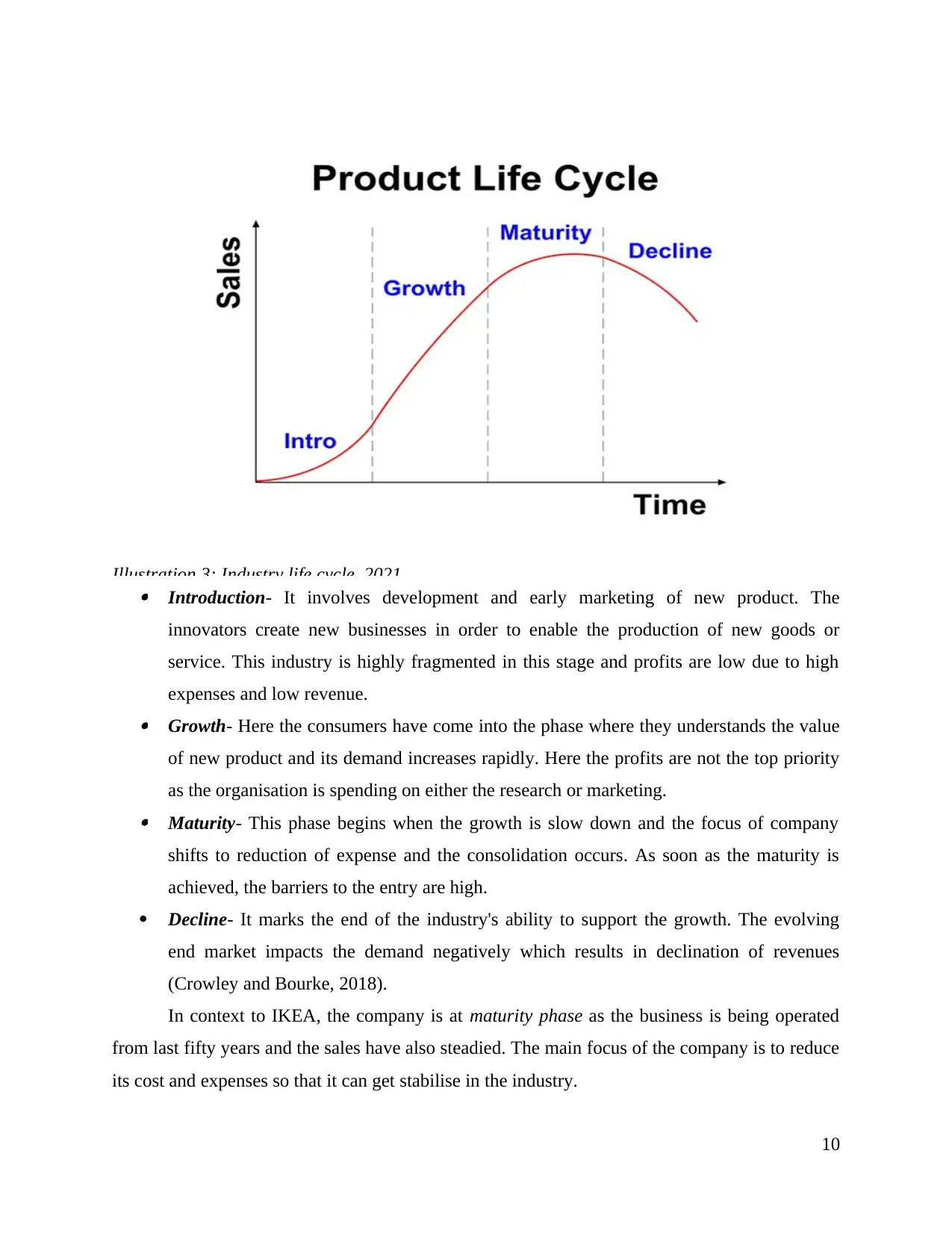
Illustration 3: Industry life cycle, 2021
Introduction- It involves development and early marketing of new product. The
innovators create new businesses in order to enable the production of new goods or
service. This industry is highly fragmented in this stage and profits are low due to high
expenses and low revenue. Growth- Here the consumers have come into the phase where they understands the value
of new product and its demand increases rapidly. Here the profits are not the top priority
as the organisation is spending on either the research or marketing. Maturity- This phase begins when the growth is slow down and the focus of company
shifts to reduction of expense and the consolidation occurs. As soon as the maturity is
achieved, the barriers to the entry are high.
Decline- It marks the end of the industry's ability to support the growth. The evolving
end market impacts the demand negatively which results in declination of revenues
(Crowley and Bourke, 2018).
In context to IKEA, the company is at maturity phase as the business is being operated
from last fifty years and the sales have also steadied. The main focus of the company is to reduce
its cost and expenses so that it can get stabilise in the industry.
10
Introduction- It involves development and early marketing of new product. The
innovators create new businesses in order to enable the production of new goods or
service. This industry is highly fragmented in this stage and profits are low due to high
expenses and low revenue. Growth- Here the consumers have come into the phase where they understands the value
of new product and its demand increases rapidly. Here the profits are not the top priority
as the organisation is spending on either the research or marketing. Maturity- This phase begins when the growth is slow down and the focus of company
shifts to reduction of expense and the consolidation occurs. As soon as the maturity is
achieved, the barriers to the entry are high.
Decline- It marks the end of the industry's ability to support the growth. The evolving
end market impacts the demand negatively which results in declination of revenues
(Crowley and Bourke, 2018).
In context to IKEA, the company is at maturity phase as the business is being operated
from last fifty years and the sales have also steadied. The main focus of the company is to reduce
its cost and expenses so that it can get stabilise in the industry.
10
Paraphrase This Document
Need a fresh take? Get an instant paraphrase of this document with our AI Paraphraser
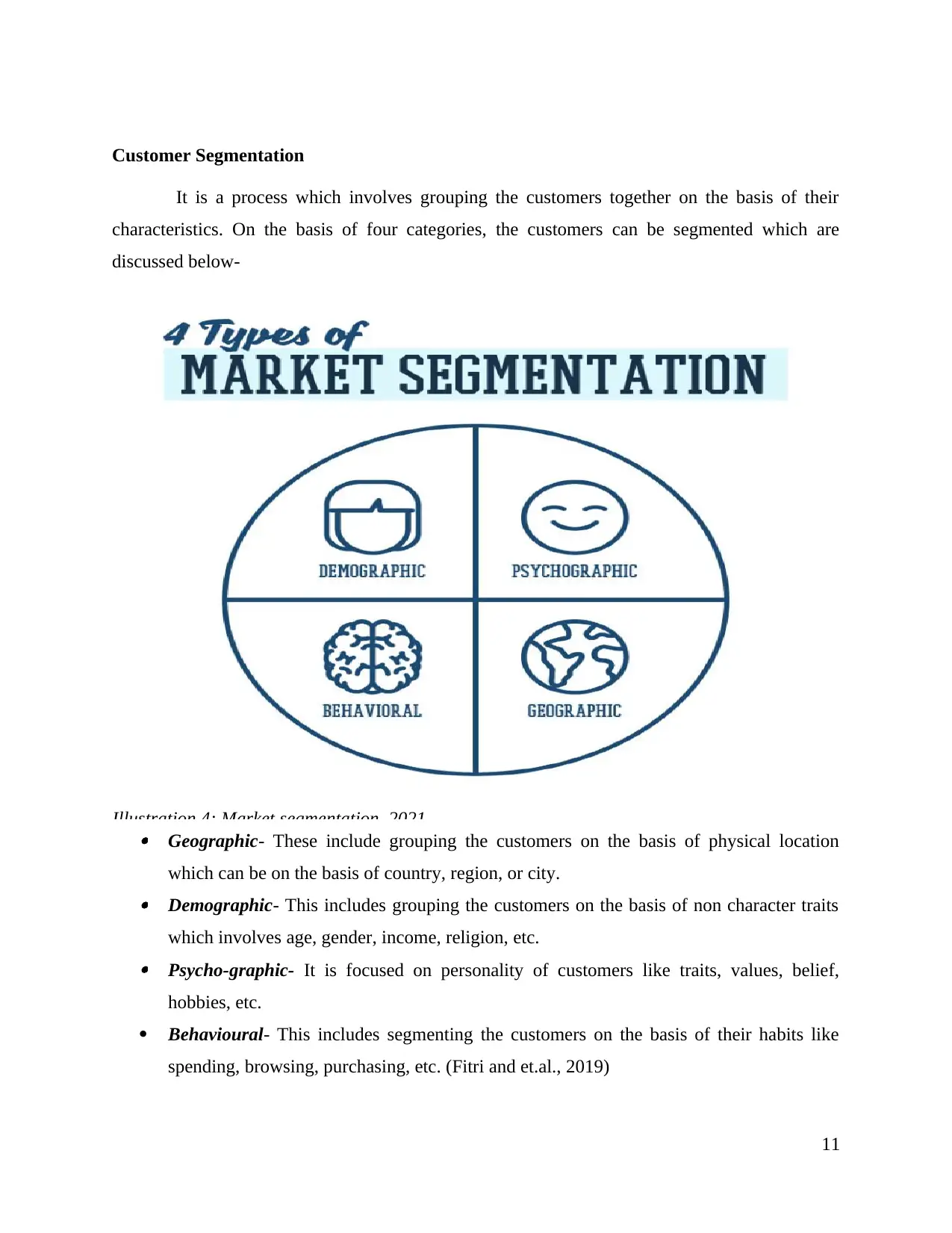
Customer Segmentation
It is a process which involves grouping the customers together on the basis of their
characteristics. On the basis of four categories, the customers can be segmented which are
discussed below-
Illustration 4: Market segmentation, 2021
Geographic- These include grouping the customers on the basis of physical location
which can be on the basis of country, region, or city. Demographic- This includes grouping the customers on the basis of non character traits
which involves age, gender, income, religion, etc. Psycho-graphic- It is focused on personality of customers like traits, values, belief,
hobbies, etc.
Behavioural- This includes segmenting the customers on the basis of their habits like
spending, browsing, purchasing, etc. (Fitri and et.al., 2019)
11
It is a process which involves grouping the customers together on the basis of their
characteristics. On the basis of four categories, the customers can be segmented which are
discussed below-
Illustration 4: Market segmentation, 2021
Geographic- These include grouping the customers on the basis of physical location
which can be on the basis of country, region, or city. Demographic- This includes grouping the customers on the basis of non character traits
which involves age, gender, income, religion, etc. Psycho-graphic- It is focused on personality of customers like traits, values, belief,
hobbies, etc.
Behavioural- This includes segmenting the customers on the basis of their habits like
spending, browsing, purchasing, etc. (Fitri and et.al., 2019)
11
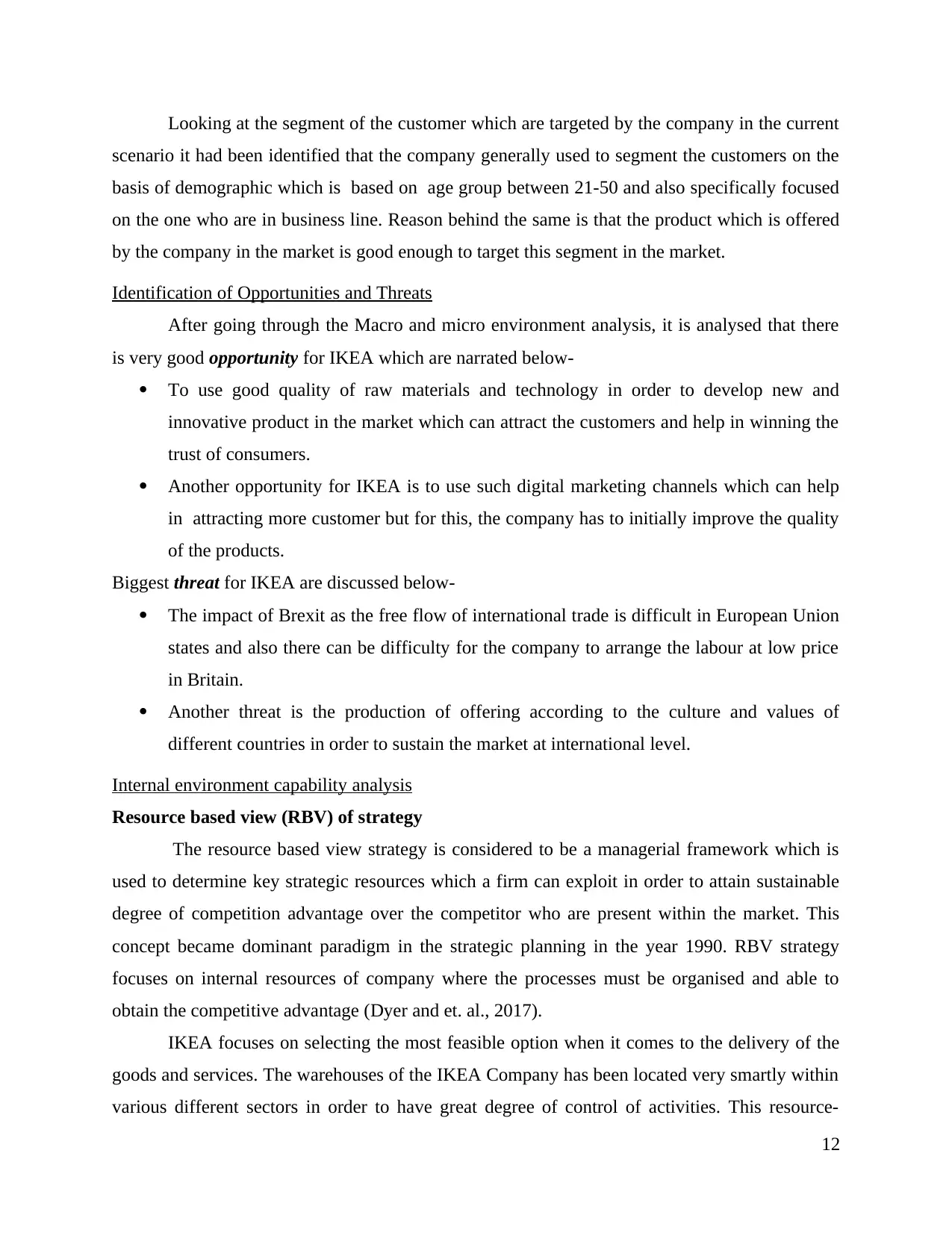
Looking at the segment of the customer which are targeted by the company in the current
scenario it had been identified that the company generally used to segment the customers on the
basis of demographic which is based on age group between 21-50 and also specifically focused
on the one who are in business line. Reason behind the same is that the product which is offered
by the company in the market is good enough to target this segment in the market.
Identification of Opportunities and Threats
After going through the Macro and micro environment analysis, it is analysed that there
is very good opportunity for IKEA which are narrated below-
To use good quality of raw materials and technology in order to develop new and
innovative product in the market which can attract the customers and help in winning the
trust of consumers.
Another opportunity for IKEA is to use such digital marketing channels which can help
in attracting more customer but for this, the company has to initially improve the quality
of the products.
Biggest threat for IKEA are discussed below-
The impact of Brexit as the free flow of international trade is difficult in European Union
states and also there can be difficulty for the company to arrange the labour at low price
in Britain.
Another threat is the production of offering according to the culture and values of
different countries in order to sustain the market at international level.
Internal environment capability analysis
Resource based view (RBV) of strategy
The resource based view strategy is considered to be a managerial framework which is
used to determine key strategic resources which a firm can exploit in order to attain sustainable
degree of competition advantage over the competitor who are present within the market. This
concept became dominant paradigm in the strategic planning in the year 1990. RBV strategy
focuses on internal resources of company where the processes must be organised and able to
obtain the competitive advantage (Dyer and et. al., 2017).
IKEA focuses on selecting the most feasible option when it comes to the delivery of the
goods and services. The warehouses of the IKEA Company has been located very smartly within
various different sectors in order to have great degree of control of activities. This resource-
12
scenario it had been identified that the company generally used to segment the customers on the
basis of demographic which is based on age group between 21-50 and also specifically focused
on the one who are in business line. Reason behind the same is that the product which is offered
by the company in the market is good enough to target this segment in the market.
Identification of Opportunities and Threats
After going through the Macro and micro environment analysis, it is analysed that there
is very good opportunity for IKEA which are narrated below-
To use good quality of raw materials and technology in order to develop new and
innovative product in the market which can attract the customers and help in winning the
trust of consumers.
Another opportunity for IKEA is to use such digital marketing channels which can help
in attracting more customer but for this, the company has to initially improve the quality
of the products.
Biggest threat for IKEA are discussed below-
The impact of Brexit as the free flow of international trade is difficult in European Union
states and also there can be difficulty for the company to arrange the labour at low price
in Britain.
Another threat is the production of offering according to the culture and values of
different countries in order to sustain the market at international level.
Internal environment capability analysis
Resource based view (RBV) of strategy
The resource based view strategy is considered to be a managerial framework which is
used to determine key strategic resources which a firm can exploit in order to attain sustainable
degree of competition advantage over the competitor who are present within the market. This
concept became dominant paradigm in the strategic planning in the year 1990. RBV strategy
focuses on internal resources of company where the processes must be organised and able to
obtain the competitive advantage (Dyer and et. al., 2017).
IKEA focuses on selecting the most feasible option when it comes to the delivery of the
goods and services. The warehouses of the IKEA Company has been located very smartly within
various different sectors in order to have great degree of control of activities. This resource-
12
⊘ This is a preview!⊘
Do you want full access?
Subscribe today to unlock all pages.

Trusted by 1+ million students worldwide
1 out of 31
Related Documents
Your All-in-One AI-Powered Toolkit for Academic Success.
+13062052269
info@desklib.com
Available 24*7 on WhatsApp / Email
![[object Object]](/_next/static/media/star-bottom.7253800d.svg)
Unlock your academic potential
Copyright © 2020–2025 A2Z Services. All Rights Reserved. Developed and managed by ZUCOL.





